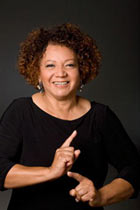
Sign
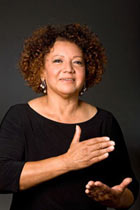
Sing
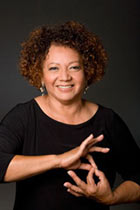
Interpret
A Sign Interpreter’s Song – by Shirley Childress Saxton
The goal and responsibility of a Sign Language Interpreter is to facilitate communication between Deaf and Hearing people. This is most effectively 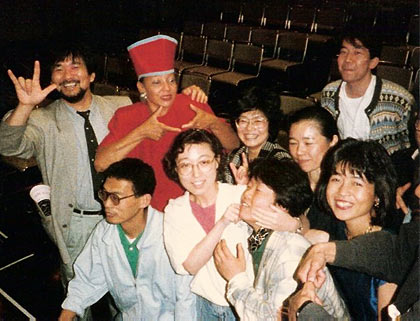 achieved by using the language of the Deaf, which is American Sign Language (ASL).
achieved by using the language of the Deaf, which is American Sign Language (ASL).
For many deaf people, music and singing are foreign media, and its relevance in their lives is debatable. Music is often perceived as another sound-based communication barrier, an instrument of discrimination and oppression of Hearing upon Deaf. So why would Deaf people be interested in a Sweet Honey In The Rock singing experience? Perhaps for some of the same reasons asHearing people – to exult, celebrate, and praise God, life and living, creativity and culture; to sing the blues or discuss politics; or maybe to share a good time with family members and friends. Each Deaf (and Hearing) person “hears” Sweet Honey differently. While the vocal harmonies may not register, a poignant message can leave a memorable impression.
The challenge of interpreting the songs of Sweet Honey In The Rock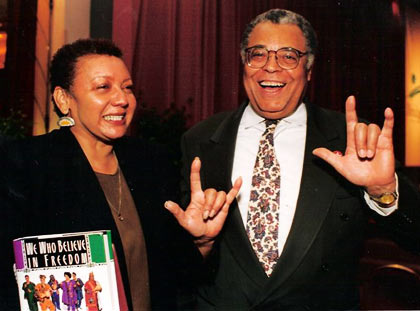 is to accurately convey the message of the songs, reflect the mood and emotional intent of the singers, and render visually the melody, harmony, and rhythm of the music. I accepted the challenge of interpreting Sweet Honey In The Rock’s message and music in 1980, after having interpreted professionally for seven years. Sweet Honey In The Rock had, in that year, made a commitment to making concerts accessible to the Deaf and to developing a Deaf audience. From the beginning, the group included the Sign Language Interpreter in her costuming and in the semi-circle in which she sits or stands to perform. This inclusion has been a clear statement to the Deaf audience that they’re included in the conversation.
is to accurately convey the message of the songs, reflect the mood and emotional intent of the singers, and render visually the melody, harmony, and rhythm of the music. I accepted the challenge of interpreting Sweet Honey In The Rock’s message and music in 1980, after having interpreted professionally for seven years. Sweet Honey In The Rock had, in that year, made a commitment to making concerts accessible to the Deaf and to developing a Deaf audience. From the beginning, the group included the Sign Language Interpreter in her costuming and in the semi-circle in which she sits or stands to perform. This inclusion has been a clear statement to the Deaf audience that they’re included in the conversation.
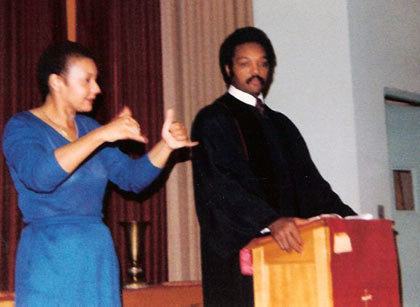 Each song is an expression of the self. Each has a story line and personality. For example, in Breaths, the tempo is slow; the attitude is spiritual, encouraging an open heart and mind. The first word is “Listen;” the first sign represents the concept of gaining one’s attention. …In my use of American Sign Language, the interpretation of a song is not an exact word-to-sign translation, but a full and vibrant visual depiction of the message.
Each song is an expression of the self. Each has a story line and personality. For example, in Breaths, the tempo is slow; the attitude is spiritual, encouraging an open heart and mind. The first word is “Listen;” the first sign represents the concept of gaining one’s attention. …In my use of American Sign Language, the interpretation of a song is not an exact word-to-sign translation, but a full and vibrant visual depiction of the message.
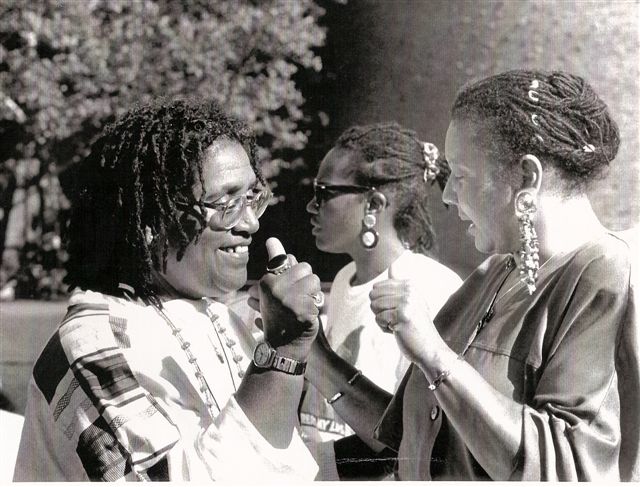 …Some songs like Fulani Chant have no words at all. Here, the interpreter is challenged to visually represent the sounds being made – a moan, a hum, a breath, a brisk wind, an ocean wave, a complex rhythm or a singer’s a cappella characterization of a musical instrument. I imagine an abstract painting using color and shape to create a picture. Thus a movement or gesture with grace or force, a fluctuation of the hand, arm, or shoulder with patterns big and small may be used in combination with verbal descriptions to help visualize the sound. Each Sign Language Interpreter will have her or his own unique interpretive style. My style tends to be fluid, loosely scripted, not static. Vocabulary and movements may change form performance to performance as the lead singer may not sing a song the same way each time it is performed.
…Some songs like Fulani Chant have no words at all. Here, the interpreter is challenged to visually represent the sounds being made – a moan, a hum, a breath, a brisk wind, an ocean wave, a complex rhythm or a singer’s a cappella characterization of a musical instrument. I imagine an abstract painting using color and shape to create a picture. Thus a movement or gesture with grace or force, a fluctuation of the hand, arm, or shoulder with patterns big and small may be used in combination with verbal descriptions to help visualize the sound. Each Sign Language Interpreter will have her or his own unique interpretive style. My style tends to be fluid, loosely scripted, not static. Vocabulary and movements may change form performance to performance as the lead singer may not sing a song the same way each time it is performed.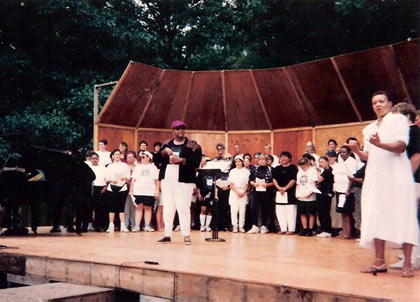
…As Sweet Honey In The Rock opens her mouth to sing, the Sign Language Interpreter moves her hands to sign. As the lyrics exclaim their message and as the melodies, harmonies, and rhythms are vocalized, they are paralleled by the poetry and power of the visual language of American Sign.
From Continuum: The First Songbook of Sweet Honey In The Rock (Contemporary A Cappella Publishing, 1999)
Photos of Shirley Saxton by Dwight Carter